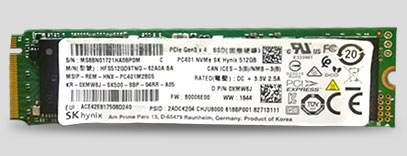Case Study
Data Recovery from Non-Detected M.2 SSD with Firmware Corruption
Due to inaccessible 512 GB data with no backup, customer project deliveries were impacted
Published On :
The customer reported that the computer system was not able to recognize the M.2 SSD. The customer made multiple attempts to access the data by connecting the M.2 SSD to different devices via the USB connectors, but to no avail.
Intel M.2 SSD has different configuration, based upon the notch (the edge connector) position. The different configuration and complex architecture of M.2 SSD make it difficult to resolve the issues of non-detection of SSD.
After making many failed attempts, the customer sought help from Stellar Data Recovery experts and submitted the SSD at our data recovery lab. Our experts examined the SSD and found that SSD was not detecting in the system due to firmware corruption.
This case study outlines successful data recovery from Non-Detecting Intel M.2 SSD with firmware corruption.
The customer is a professional and works with many international clients on different assignments. The customer’s project deliveries will going to be hugely impacted, if the data from non-detecting 512 GB Intel M2 SSD is not recovered.
There were some important project deliveries to be made within the next few weeks. The inability to access important project data and fear of missing the project deliveries was making the customer nervous.
Non deliveries of projects would cause him financial losses and also impact his professional reputation.
How to recover data from Intel M.2 512 GB SSD with firmware corruption and to help customer recommence his project deliveries?

Our data recovery experts thoroughly analyzed the SSD and performed the following steps to successfully recover the data from Intel M.2 SSD.
Step 1: Analysis of M.2 SSD
The first thing which our experts noticed was that the SSD was not detecting when connected to the system. This was stated by the customer as well. They removed the SSD and then made another attempt to detect the SSD via a specialized tool which our experts use for SSD data recovery. This tool was able to detect the SSD, but still, data was not accessible.
After crossing the first hurdle, the next step was to find and fix the issue of inaccessible data.
Step 2: Examined the Firmware Area
In most cases when SSD is detecting in the system but data is not accessible, the possible reason could be firmware issues. “A firmware is specific computer software that performs the basic functions of input/output and offers the necessary set of instructions for the hardware to perform desired functions.”
Our experts started to examine the firmware area and found that the firmware information was severely corrupted. A detailed analysis was performed on the firmware area for the flash translation layer (FTL). “FTL is a hardware/software layer located in the controller of the storage device that makes use of flash memory and manages SSD operations.”
After completing the analysis of FTL, the presence of bad blocks was identified in the translation layer. The presence of bad blocks in the FTL layer has caused firmware corruption. This was creating a problem in accessing the data.
Step 3: Repairing the M.2 SSD
The experts then initiated the process of repairing the bad blocks. A byte chain was created by locating the healthy blocks in the FTL. Our proprietary software was used to replace the bad blocks in FTL with healthy blocks from the free space of the firmware area.
After replacing the bad blocks with healthy blocks, the team regenerated the virtual translator and accessed the data.
Step 4: Cloning of Intel M.2 SSD
The next step was to create a Clone of M.2 SSD. Before we started the cloning process, we analyzed the repaired SSD and found it in good health. After confirming the health status of SSD, we started the cloning process.
After completing the cloning process, our experts started to scan the cloned SSD by using our proprietary tool. As documented by the customer in Media Assessment Form (MAF), we were able to find files, folders, and complete data stored in Intel M.2 SSD.
A detailed directory listing report was shared with the customer to confirm the possibility of recoverable data. Once the customer confirmed that he was able to see all his important files and folders in the shared directory listing, we recovered the required data and handed over the same.
Stellar® data care experts successfully recovered 100% data from non-detected 512 GB M.2 SSD with firmware corruption.
Data was recovered in the exact state as it was desired by the customer. The customer was able to continue his projects and make deliveries of his projects within the timeframe.
100% customer satisfaction was achieved, within the estimated and promised time.
We follow ISO 9001 and ISO 27001 standards to ensure complete data privacy and integrity during the data recovery process. All the data recovery operations were carried out by following strict data privacy and security protocols.
Data recovery experts at stellar have in-depth knowledge of SSD Structure. Our experts are capable of recovering up to 100% of data from damaged SSD. Read more about our SSD data recovery capabilities.
Related Article: Some Common Warning Signs Of SSD Failure

Corporate User

Individual User

Individual User

Individual User